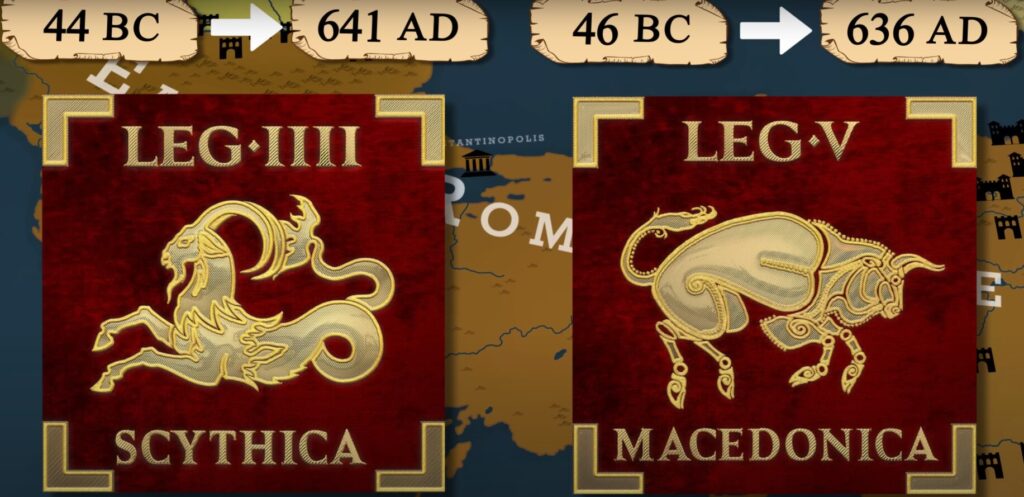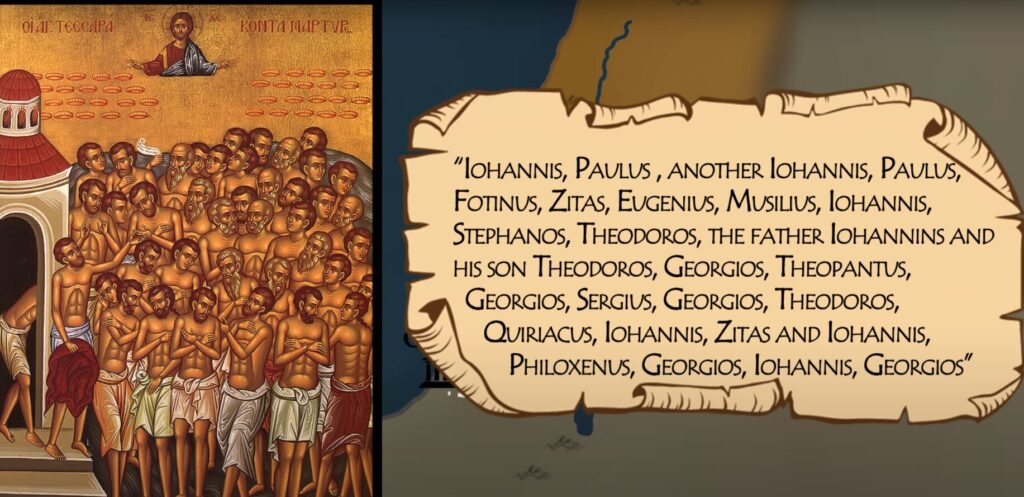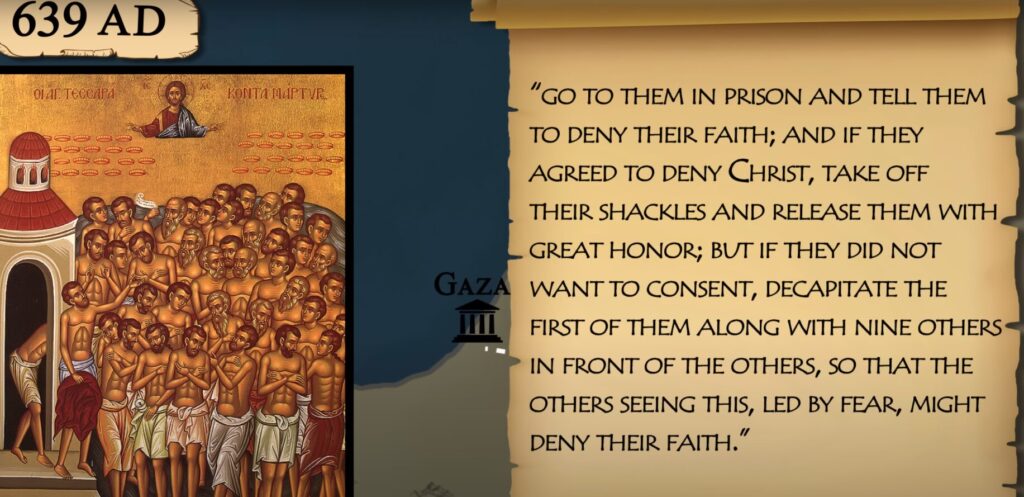The Roman legions went through major changes as the empire weakened in the fourth and fifth centuries. Once the core of Roman power, these units became smaller, less uniform, and harder to trace in the records. Many disappeared in the West during times of crisis, while others held out in frontier regions or carried their traditions into new political realities. Even after the fall of the Western Empire, traces of Roman military customs survived in places like Gaul and Noricum, showing the persistence of old loyalties and practices.
In the East, legions continued under new structures as the army shifted toward what would become the Byzantine system. Some units can still be followed in the sources for centuries, fighting in campaigns across Italy and the eastern provinces. A few legions endured into the 7th century, with their final moments recorded in battles and even in stories of martyrdom. These accounts show how the Roman military identity did not vanish suddenly but instead adapted, lingered, and left a lasting imprint on later generations.
Key Takeaways
- Roman units changed form but did not vanish at once
- Some legions survived in frontier regions and new kingdoms
- A few legions lasted into the 7th century before disappearing
Shifts in the Roman Legions
Downsizing and Shifts in Gear
By the fourth and fifth centuries, Roman legions no longer matched the large, standardized forces of earlier times. Units became smaller, and their weapons and armor gradually changed. Some groups, like those stationed in Noricum, continued to hold their posts for decades even after the empire had abandoned the region.
Examples of legions that endured in abandoned areas:
| Region | Units Still Active | Fate |
|---|---|---|
| Noricum | Legio I Noricorum, Legio II Italica, Cohors IX Batavorum | Held positions until defeated by the Heruli and Rugi in the 460s–470s |
| Gaul | Field army under Agidius | Survived as the Kingdom of Soissons until conquered by the Franks in 486 |
Even after defeat, some of these soldiers were absorbed into new armies. The Franks, for example, allowed former Roman troops to keep their banners and traditions, passing them down to later generations.
Fading Boundaries of Roman Identity
As the empire weakened, the clear identity of the legions also began to blur. Soldiers who once fought under Roman command often continued their service under new rulers, but they held onto Roman customs, uniforms, and standards.
Procopius described how descendants of Roman units in Gaul still marched with their own symbols and wore Roman-style clothing nearly seventy years after the Western Empire’s fall. This shows that even when the name legion disappeared in the East during reforms under Zeno and Anastasius, the traditions of these units persisted.
- Some legions, like the Flavia Theodosiana, could still be traced into the sixth century.
- Others, such as the Macedonica, lasted into the seventh century, fighting at Yarmuk before vanishing.
- A final record comes from Christian accounts of soldiers from the Scythia units executed in 639, showing how long the Roman military legacy endured.
The gradual merging of Roman legions into local and successor armies illustrates how their identity shifted from a strictly Roman force into a broader tradition carried by new powers.
Fading of Western Roman Legions

Disappearing Forces in the Fifth Century
During the fifth century, many Western Roman legions vanished from records. Some were likely destroyed in battle, while others dissolved due to lack of pay, supplies, or reinforcements.
Even after provinces were abandoned, small garrisons sometimes held on. In Noricum, for example, units such as Legio I Noricorum, Legio II Italica, and the ninth cohort of Batavians remained active into the 460s and 470s. Written evidence shows the Batavians even sent a delegation to Ravenna to request their salaries.
In Gaul, the field army under Agidius broke away after 460 and survived as the Kingdom of the Soissons until it fell to the Franks in 486. Remarkably, later sources describe descendants of these soldiers still serving under the Franks while preserving Roman standards, dress, and traditions.
Key examples of late survival:
- Noricum frontier units – active until conquest by the Heruli and Rugi.
- Field army of Gaul – endured as an independent force until 486.
- Roman traditions under the Franks – maintained uniforms, standards, and customs for generations.
Example: Undeani and Eleventh Claudia
One of the most notable cases of disappearance involves the Undeani, descendants of Legio XI Claudia. Once considered a powerful unit, they eventually disappeared during the turmoil of the fifth century.
Their decline reflects the larger collapse of Western legions. Without stable leadership, supply lines, or funding, even long-standing units could not survive. The fate of the Undeani illustrates how once-prominent legions faded quietly from history, leaving only traces of their existence in scattered accounts.
Factors in their disappearance:
- Lack of reinforcements
- Shortages of pay and supplies
- Political instability in the Western Empire
Survival and Legacy in Noricum and Gaul
Border Troops in Noricum
Even after the Western Empire abandoned Noricum in the mid-5th century, small groups of soldiers remained at their posts. Units such as Legio I Noricorum, Legio II Italica, and the Cohors IX Batavorum continued to guard the region. Their presence lasted into the 460s and 470s, when invading groups like the Heruli and Rugi finally overcame them.
Request for Pay in Ravenna
One surviving cohort in Noricum even attempted to maintain ties with the imperial center. Records show they sent a delegation to Ravenna, the Western capital, to demand their unpaid wages. This effort highlights both their loyalty to Rome and the empire’s inability to support them during its decline.
Army of Gaul under Aegidius
In Gaul, the army led by Aegidius broke away from imperial control after the death of Emperor Majorian in 460. This force held out independently and later developed into the domain of the Soissons. It survived the fall of the Western Empire in 476 but was eventually defeated by the Franks in 486.
Timeline of Events in Gaul
| Year | Event |
|---|---|
| 460 | Aegidius separates from Rome |
| 476 | Western Empire collapses |
| 486 | Franks conquer Soissons |
Soissons Troops within the Frankish Realm
Even after conquest, remnants of the Gallic field army did not disappear. Procopius, writing decades later, described a Frankish contingent that still carried Roman standards and wore Roman-style clothing and footwear. These soldiers preserved the customs of their ancestors and passed them down to later generations.
- Maintained Roman dress and arms
- Carried unit standards in battle
- Served as effective mercenaries under Frankish kings
This continuity shows how Roman military traditions survived within new powers, blending into the Frankish world while still keeping a strong sense of their Roman past.
Survival of Roman Military Traditions

Roman Heritage in Frankish Forces
Even after the fall of the Western Empire, parts of the Roman field army in Gaul continued to exist under new rulers. When the Franks defeated these troops, they did not erase their identity. Instead, they allowed them to serve as mercenaries while keeping their Roman standards, uniforms, and even footwear.
These soldiers passed their traditions down to their descendants. Two generations later, observers still recognized them as Roman in appearance and custom. Their presence within the Frankish army shows how Roman identity remained visible long after the empire’s collapse.
Key features they preserved:
- Standards: Military emblems carried into battle.
- Dress: Roman-style clothing and shoes.
- Customs: Rituals and practices inherited from their fathers.
Carrying Forward Symbols and Practices
The endurance of Roman traditions was not limited to appearance. Standards and customs acted as a link between past and present. These symbols gave soldiers a sense of continuity with their ancestors and reinforced group identity.
| Tradition | Function | Example in Use |
|---|---|---|
| Standards | Served as rallying points in battle | Carried by descendants of Roman legions in Frankish service |
| Uniforms | Marked Roman identity | Soldiers kept Roman dress, including footwear |
| Customs | Preserved discipline and cohesion | Practices passed down from fathers to sons |
By keeping these elements alive, the descendants of Roman legions ensured that Roman military culture remained active in Europe even after the political empire had ended.
Eastern Roman Legions and Byzantine Reforms
Frontier Soldiers and Their Duties
In the eastern provinces, many Roman units continued to serve as border troops, often called limitanei. These soldiers guarded frontier zones, maintained forts, and provided a first line of defense against raids. Unlike mobile field armies, they lived close to the land they defended and often blended into local communities.
Key roles included:
- Guarding fortifications and watchtowers
- Patrolling border regions
- Supporting field armies during invasions
Although their status was lower than that of field troops, they preserved the traditions of earlier legions while adapting to new conditions.
Changes under Zeno and Anastasius
During the reigns of Zeno and Anastasius, the army underwent major reforms. The introduction of the numerus system reorganized units and shifted the structure of the military toward what became the Byzantine model.
- Old legions were rebranded under new names.
- Frontier units were reinforced and integrated into the new system.
- Pay and supply were adjusted to stabilize service.
This period marked the transition from the Roman legionary framework to a reorganized Byzantine force, ensuring continuity while reshaping the army for new challenges.
End of the Legion Name
By the time of Justinian I, the word legion (legio) disappeared from official use. Units that once carried this title were renamed, and the term no longer appeared in records.
| Old Term | New System | Example |
|---|---|---|
| Legio | Numerus | First Flavia Theodosiana |
| Limitanei | Reinforced frontier troops | Survived into 6th century |
Even though the designation ended, soldiers still remembered the traditions of their units. Some legions could be traced in later battles, such as the First Flavia Theodosiana fighting in Italy during the 6th century. Others, like the Fourth Parthica and Fifth Macedonica, endured for centuries before vanishing in later wars.
The name changed, but the legacy of the Roman legions lived on within the Byzantine military system.
Tracking the Last Roman Legions

The Theodosian Legion in Italy
The unit known as the Theodosian Legion traced its roots back to the 4th century under Emperor Theodosius. Records show that it joined Belisarius during his campaign in Italy in 535 AD. Evidence from a letter by Pope Gregory the Great confirms that the legion remained active decades later, defending Rome against Lombard attacks.
Key Details:
- Origin: Raised in the 4th century
- Campaign: Took part in Belisarius’s Italian conquest
- Later Role: Defended Rome in the late 6th century
The Fourth Legion and the Battle of Solachon
The Fourth Legion, originally created under Diocletian, survived into the late 6th century under a new name. A soldier from this unit fought at the Battle of Solachon in 586 AD. Sources describe his severe wounds in detail, including injuries from arrows, spears, and a javelin. Despite medical efforts, he died shortly after the battle, remembered for his bravery.
Battle Notes:
- Raised: Late 3rd century
- Renamed: Known as Coartoarthon
- Event: Fought at Solachon, 586 AD
- Outcome: Soldier mortally wounded, remembered as heroic
The Fifth Macedonian Legion and Yarmouk
The Macedonian Legion had one of the longest histories of any Roman unit, dating back to Pompey’s campaigns in 46 BC. Remarkably, it endured until the 7th century. Its final appearance was at the Battle of Yarmouk in 636 AD, where it was destroyed along with many other Roman forces.
Timeline of Service:
- Founded: 46 BC under Pompey
- Longevity: About 685 years of activity
- Final Battle: Yarmouk, 636 AD
- Fate: Annihilated during the Arab conquests
The Last Known Legions and Acts of Martyrdom
Wunari and Skidi in Gaza
In 639 AD, during the Arab capture of Gaza, sixty soldiers from the Wunari and Skidi units were taken prisoner. Their captors attempted to convert them, promising freedom and honor if they renounced their faith.
When the soldiers refused, the executioner was ordered to kill ten men in front of the rest to instill fear. None of the survivors yielded, and the executions continued. Among those named were Erias, Kiticus, Illustrius, Theodoris, and Stfanis, all members of the Skidi.
A simple breakdown of events:
| Event | Outcome |
|---|---|
| Offer of conversion | Soldiers refused |
| First 10 executed | Others remained steadfast |
| Continued executions | All remained faithful |
Christian Memory and Heritage

Christian tradition preserved the account of these soldiers, framing their deaths as a testament to loyalty and faith. Their refusal to abandon their beliefs, even when offered life and honor, became part of the record of late Roman military history.
This account highlights how the identity of Roman units endured beyond the empire itself. The soldiers of Wunari and Skidi were remembered not only as warriors but also as martyrs, linking the legacy of the Roman legions with the memory of Christian sacrifice.
